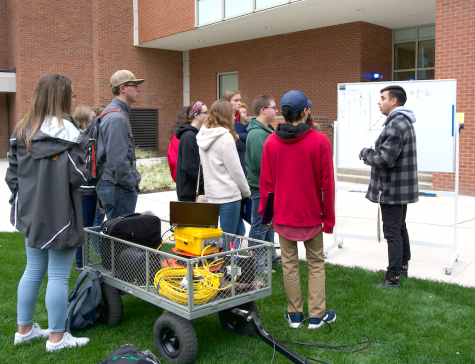High school students invited to participate in EES Day
The Wilkes University College of Science and Engineering hosted Earth and Environmental Science (EES) Day on Oct. 18. The purpose of EES Day is to grant high school students the chance to participate in interactive lab activities and presentations hosted by faculty experts from the EES Department.
The activities for the day were hosted on the Greenway and in the Cohen Science Center. Students rotated between stations learning about topics such as gravity anomalies, climate change, soil quality and utility, water quality, watersheds and the impact of weather.
“EES Day exposes high school students to the potential education and career opportunities in the broad field of the geosciences. Many high school students are unaware of the professional opportunities in the geosciences,” said Julie McMonagle, lecturer/lab manager for the Department of Environmental Engineering and Earth Science.
She continued, “EES Day is an event where students can engage in hands-on lab activities in these subjects.”
McMonagle supervised the “Soil Secrets – The Food Factory of Life” session, which highlighted the importance of soil and its capabilities in functioning like a factory. McMonagle led students in a discussion about how the production of crops and plants consists of inputs and wastes, just like a factory.
The inputs are sunlight, fertilizers and fossil fuels to power machinery used for growing and maintaining crops. The waste is emissions from fossil fuels, as well as any harmful effects left by pesticides and fertilizers.
In addition to this, McMonagle also spoke about the importance of color and grain size when it comes to soil. Students did numerous lab activities working with grain size and color of the soil. Soil grain sizes can range from the smallest, clay, to other sizes like sand and silt.
Grain size and color are both important features that can play a critical role in working soil, something environmental scientists, geologists and environmental engineers all may do in their fields of study and work.
Another station was “Grasping the Gravity of the Situation: Gravity Anomalies and Earth Structures” in which students on the Greenway gathered data about anomalies in gravity.

Dr. Bobby Karimi, assistant professor of environmental engineering and Earth sciences, explains to visiting students his station on gravity anomalies.
“I enjoyed the gravity station. By hitting the pallet with the sledgehammer, I think we got a lot of different data,” Melanie Martinez, senior from Pocono Mountain West High School, said. “There was a lot to see and the campus seems easy to get around.”
There were 116 students in attendance from different high schools.
Jack Feightner and Zach Zechman, juniors from Wyomissing Area Junior/Senior High School, were impressed by the labs on campus and the faculty chosen to run the activities for EES Day.
“Today has been very informational. It is empowering young leaders to learn and make a change about global climate change,” Feightner continued. “I think all of the lectures were excellent and the faculty were all experts in their topics.”
“It was great to perform labs at a college setting that we would not be able to at our high school,” Zechman added.
Feightner and Zechman engaged in a discussion with Dr. Matthew Finkenbinder, assistant professor of geology, environmental engineering and Earth sciences about climate change.
Finkenbinder’s lecture and activity focused on the connection between climate change and the disappearance of glaciers.
By using time-lapses, Finkenbinder showcased that glaciers have been undergoing glacial retreat, where ice melts more than snow is produced. It’s the opposite of glacial advance, where the cold temperature creates more snow to help glaciers grow.
The importance is that the net loss of glacial ice is complimentary evidence towards climate change and global warming. The specific example Finkenbinder used was Glacial National Park in Montana, which has gone from 150 glaciers in 1850 to only 26 glaciers by 2009.
The other lectures and activities held throughout the day were, “Is your Water Safe to Drink? Constructing a Water Filtration System,” “The Magic of Maps – Geospatial Technologies to Assess Watersheds and Water Quality” and “Flash, Bang, Boom, Measuring Weather in the Backyard.”
In addition to activities and lectures for students, EES Day also served as a way for faculty and alumni to talk with parents and guardians about the admissions process, financial aid and about career paths available to students who major in earth and environmental science.
In attendance at EES Day was Tyler Marino, an EES graduate from the Class of 2014.
“I came and shared my experiences as alumni. I talked to parents about how my EES major helped me to get my job with PPL,” Marino continued. “I think it is important because the Earth and Environmental Science Department gives you a clear picture of the problems our world is facing and how to solve them.”
Sean is a sophomore communication studies major who started as a staff writer in the fall of 2018. Sean currently works as the Assistant News Editor, a...